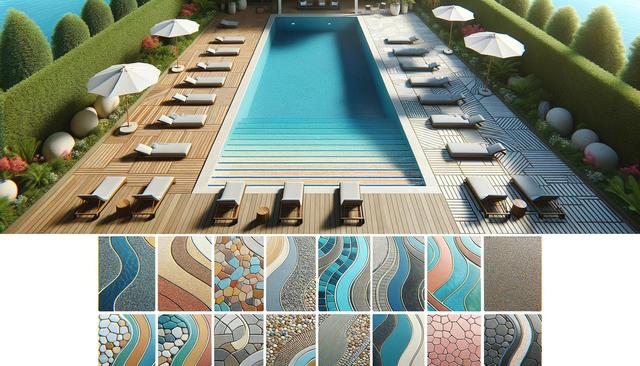Understanding the Need for a Pool Deck Makeover
Over time, pool decks are subject to wear and tear from harsh weather, pool chemicals, and foot traffic. Cracks, discoloration, and surface erosion not only reduce the visual appeal but can also create safety hazards. A comprehensive pool deck makeover is an effective way to rejuvenate the space without the need for a full replacement. Resurfacing is often the preferred solution, offering a variety of techniques tailored to different budgets, styles, and performance needs. Whether you’re aiming for a sleek modern look or a textured, slip-resistant surface, understanding the available options will help you make an informed decision that aligns with your functional and design goals.
Stamped Concrete: Style Meets Functionality
Stamped concrete is a widely used resurfacing technique that combines durability with decorative potential. This method involves applying a new layer of concrete over the existing deck, then imprinting it with patterns that mimic natural materials such as stone, brick, or slate. The outcome is a visually appealing surface that offers the charm of high-end finishes without the associated cost. Benefits of stamped concrete include:
- Customizable colors and patterns
- High resistance to wear and weather
- Low maintenance requirements
Although it offers many advantages, stamped concrete does require periodic sealing to maintain its appearance and prevent fading or moisture penetration. It’s also important to ensure that the surface is treated for slip resistance, especially in wet pool environments.
Spray Texture Coatings: A Popular Choice for Safety and Comfort
Spray texture coatings, often referred to as knockdown finishes, are another leading option for pool deck resurfacing. These coatings are applied using a spray gun, followed by a trowel process that creates a subtle texture. This technique is especially favored for its slip-resistant properties and its ability to stay cooler underfoot compared to traditional concrete surfaces. Key features include:
- Improved traction for enhanced safety
- Cool surface temperature, ideal for hot climates
- Variety of color options to match outdoor décor
Spray texture coatings are very effective for older concrete decks that need a visual upgrade and improved functionality. They can also be customized to include decorative elements like stenciled patterns or colored borders, offering a balance between aesthetics and practicality.
Paver Overlays: Classic Appeal with Modular Flexibility
Paver overlays offer a versatile and timeless option for pool deck resurfacing. This method involves laying thin pavers or tiles directly over the existing surface using a specialized bonding agent. The result is a clean, modular appearance that can be easily repaired or updated in sections. Advantages of paver overlays include:
- Easy replacement of individual units if damaged
- Wide range of shapes, sizes, and materials
- Natural drainage through joint spaces
However, proper installation is essential to prevent shifting or settling over time. A solid and level base is critical to ensure long-term performance. While the initial cost may be higher compared to other techniques, many homeowners appreciate the aesthetic and functional benefits that pavers provide.
Epoxy and Polyurethane Coatings: High Performance and Visual Impact
For those seeking a high-performance surface with a modern look, epoxy and polyurethane coatings are worth considering. These coatings are applied as liquids and cure into a strong, seamless surface that resists chemicals, water, and UV damage. Often used in commercial settings, they are gaining popularity in residential spaces for their sleek finish and durability. Some notable features include:
- Highly resistant to stains and pool chemicals
- Available in solid colors, metallics, or speckled finishes
- Fast curing times with minimal downtime
Despite their advantages, these coatings may become slippery when wet, so incorporating anti-skid additives is crucial. Additionally, surface preparation is key to ensuring proper adhesion and preventing future peeling or bubbling. When properly installed, epoxy and polyurethane coatings offer an attractive and long-lasting solution for pool deck resurfacing.
Conclusion: Choosing the Right Resurfacing Technique for Your Needs
Each pool deck resurfacing technique brings its own unique set of benefits, making it important to align your choice with your specific priorities—whether that’s safety, aesthetics, budget, or maintenance needs. Stamped concrete offers a decorative and cost-effective option, while spray texture coatings provide comfort and slip resistance. Paver overlays cater to those who prefer a classic, adaptable look, and epoxy or polyurethane coatings deliver high durability with a modern flair. By understanding these options and assessing your pool area’s conditions and usage, you can confidently invest in a pool deck makeover that enhances both the beauty and functionality of your outdoor space.







